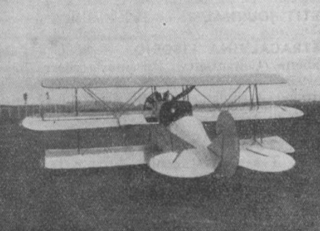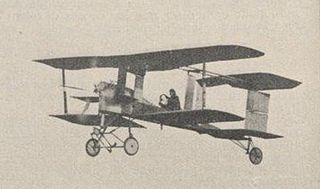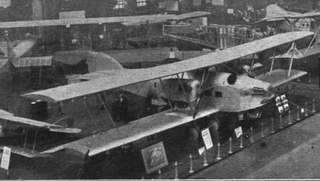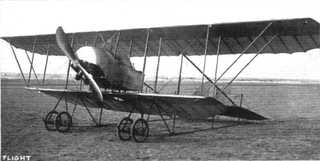
The Voisin Canard was an aircraft developed by Voisin brothers during 1910 and first flown early in 1911. It was named the Canard because of the resemblance of its forward fuselage to that of a duck's long neck while in flight. It was originally flown as a landplane: with the addition of floats it became one of the first seaplanes used by the French Navy.

The Blackburn Triplane was a single-engine pusher single-seater, designed specifically to attack Zeppelins. It flew in 1917, but was not successful.

The Dunne D.8 of 1912 was a tailless swept wing biplane, designed by J. W. Dunne to have inherent stability. One example was supplied to RAE Farnborough. License-built Burgess-Dunne models were used by the US Signal Corps and United States Navy and the short-lived Canadian Aviation Corps. It was the latter's first and only warplane.
The Graham-White Type VII "Popular" was an early British aircraft designed by J. D. North and built by the Grahame-White Aviation company, with the intention of producing a low-cost aircraft to popularize aviation. It was initially produced with a 35 hp Anzani 3-cylinder Y configuration engine and offered for sale at a price of less than £400. Despite its low price the aircraft included structural refinements such as hollow-section interplane struts. It was first flown in 1913.

The Caproni-Pensuti 2 was a small single-engine sports triplane aircraft designed and built in Italy just before the end of World War I. It had a wingspan of only 4.0 m or a little over 13 ft.

The Paalson Type 1, (Pålson), was a Swedish single-seat sport aircraft built around 1920. It was of conventional single-seat biplane layout but had some unusual features such as girder type interplane struts, a novel main undercarriage axle mounting and a mechanism allowing adjustment of the angle of incidence of the upper wing.

The Voisin Type de Course was an early French aircraft built by Voisin Frères. It was first flown early in 1910.

The Paulhan biplane was a French experimental aircraft designed in 1910 by the successful aviator Louis Paulhan in collaboration with Henri Fabre. The prototype became the second aircraft bought by the British War Office: two further examples, differing in constructional detail, were built.

The Bréguet Type II was the second fixed-wing aircraft design produced by Louis Bréguet. Built during late 1909, it was soon discarded in favour of his next design, the Bréguet Type III

The Potez XVIII was a French airliner from the early 1920s, a three-engine biplane carrying up to twelve passengers.

The Caudron Type O was a French single seat air racing biplane first flown in 1914.

The Hydroaéroplane Caudron-Fabre, (Caudron-Fabre), was a French amphibious seaplane which competed in the 1912 Monaco event. It was one of the first true amphibians, able to take-off from water and touch down on land.
The Caudron Type H was a collective name for three different Caudron designs of 1912-3. One of these was an amphibious three seat biplane built for the French military. Two were completed, one appearing at the Paris Aero Salon in November 1912.

The Caudron Type L was a two-seat French pusher configuration amphibious biplane, flown around 1913 and intended for naval use.
The Caudron Type B was a 1911 development of the earliest Caudron type, the Caudron Type A, with a nacelle style fuselage and more powerful engine. Initially an equal span biplane, it was modified into a sesquiplane.
The Caudron Type K was a French floatplane with a very powerful, twenty cylinder radial engine in pusher configuration. It took part in a French seaplane competition in 1913, but was lost in a take-off accident during the competition.
The Caudron Type C was a single seat French biplane, intended for military evaluation. Two were built in 1911.

The Caudron Type F was a French single seat biplane produced just before World War I. A dozen were bought by China and at least two other examples, with different engines, competed in 1913, coming first and second in the biplane category of the cross-country race at Reims. Flown by Pierre Chanteloup, one was the first biplane to loop-the-loop.

The Caudron Type D was a French pre-World War I single seat, twin-boom tractor biplane, a close but slightly smaller relative of the two seat Caudron Type C. More than a dozen were completed, one exported to the United Kingdom, where they may also have been licence built, and three to China.
The Caudron Type E two seat trainer was a larger and more powerful development of the Type C. Two or three were bought by the French military and one by the Royal Navy just before World War I but its sales were overtaken by the superior Type G.














